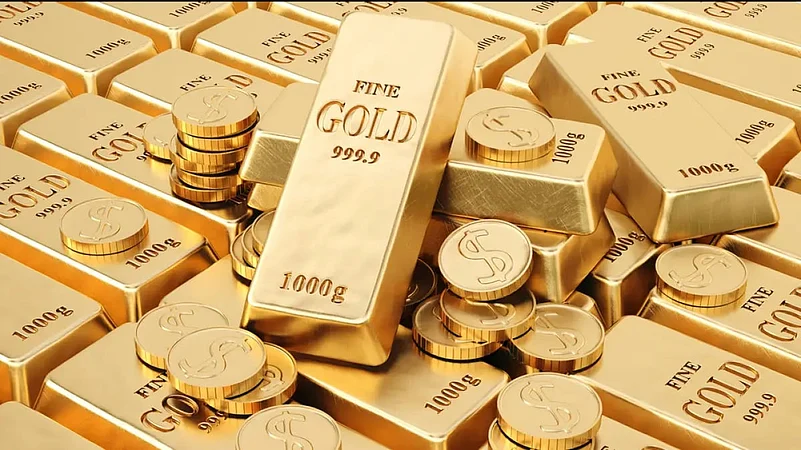In a bearish market, investors typically prefer to buy gold, and at times of high inflation and market volatility, gold is considered by many as a ‘safe haven’ asset. But lately, the price of gold has been on a downward journey. It has fallen by as much as 6.06 per cent from Rs 53,890 on March 8, 2022 to Rs 50,619 on June 23, 2022.
Incidentally, when the Russia-Ukraine war began, gold prices rose above $2,000 on COMEX, a division of the Chicago Mercantile Exchange, and on India’s Multi Commodity Exchange (MCX), gold prices rose by 4.66 per cent to Rs 52,559 on March 7, 2022.
Says Sriram Iyer, senior research analyst, Reliance Securities: “The unexpected Russia-Ukraine war did lift prices above $2,000/ounce. Geopolitical factors caused a crisis impact, because gold acts as a safe haven, and it outperforms other asset classes.”
Megh Mody, Commodities and Currencies Research Analyst at Prabhudas Lilladher says that gold is a hedging tool against inflation and its price reacts to inflation numbers at times, but that’s not the case always.
“When there was a rising geopolitical issue, gold saw a stupendous rise, but it was short-lived as the US Fed came back to control inflation. Gold is a hedging tool against inflation, and hence, price reacts to inflation numbers, but not always. Typically, the value of gold rises when the cost of living increases. But now, gold remains under pressure on the back of the dollar index, which is currently trading higher amid rising inflation in the US,” added Mody.
According to experts, there are few possible reasons for this.

Gold’s Relation With Dollar: Iyer said that normally gold is one of the hedges used in tackling rising inflation. But that said, it is not a perfect hedge. “After the US inflation reached 8.6 per cent, the US Fed increased the interest rate by 0.75 per cent, and this resulted in the dollar appreciating. The 10-year US benchmark interest rate reached 3 per cent following this decision by the Fed. So, the age-old argument of gold being in an inverse relationship with the dollar holds true now, too,” added Iyer.
Iyer further said that they currently believe that the US Fed will go for a gradual interest rate hike rather than get aggressive, so that the US economy does not go into recession. Hence, the current negative impact on gold prices is because of gradual rate hikes, and it is not aggressive.
“More aggressive tightening (of interest rates) could lead to recession and could push investors towards gold to counter a fall in riskier asset classes like equities,” he added.
Gold Prices Are Demand Driven: Gold is an asset, which inherently does not yield any interest or income, and is purely driven by the economic forces of demand and supply. Deepesh Raghaw, founder, PersonalFinancePlan, a Sebi-registered Investment Advisor (IA), explains that normally when people buy other asset classes, they check the asset’s future earning potential, cash flow generating capacity, interest income in case of bonds, among others. But in the case of gold, the returns on it are driven purely by the market forces of demand and supply.
“Hence one of the factors which may be causing prices of gold to be down now is that the demand for gold is not that strong among market participants, and they are preferring other assets, which may provide them with better returns,” he adds.
Treasury Yields: Central banks across the world, including the Reserve Bank of India (RBI) have raised interest rates to curb the ongoing problem of inflation.
According to Mohit Nigam, head of PMS, Hem Securities, a strong dollar and higher bond yields have put pressure on the price of gold. As a result, the dollar has become attractive for investors.
“While gold is viewed as a hedge against inflation, rising US interest rates increase the opportunity cost of holding non-yielding bullion, as gold yields no interest, and it is not good for gold prices as the money will now move back to debt. Gold prices are falling as an uptick in the dollar, and US bond yields overshadowed support from concerns over soaring inflation,” he added.
China Impact: China is the world’s largest gold consumer, and in 2021, according to data released from China Customs, they imported 818 tonnes of gold and consumed 1,120.9 tonnes of gold. The demand for gold in China had surpassed its production by a wide margin many years ago, and hence China had started importing gold to fulfil the increased demand.
But recently according to analyst reports from Nomura Security holdings and others, China has been facing difficulties in achieving its 5.5 per cent GDP growth target.
“With the Covid-19 outbreaks suppressing a wide range of sectors, including in-person services, construction, and some manufacturing activity, it’s getting harder for Beijing to achieve its 5.5 per cent GDP growth target for 2022,” read an analyst report.














